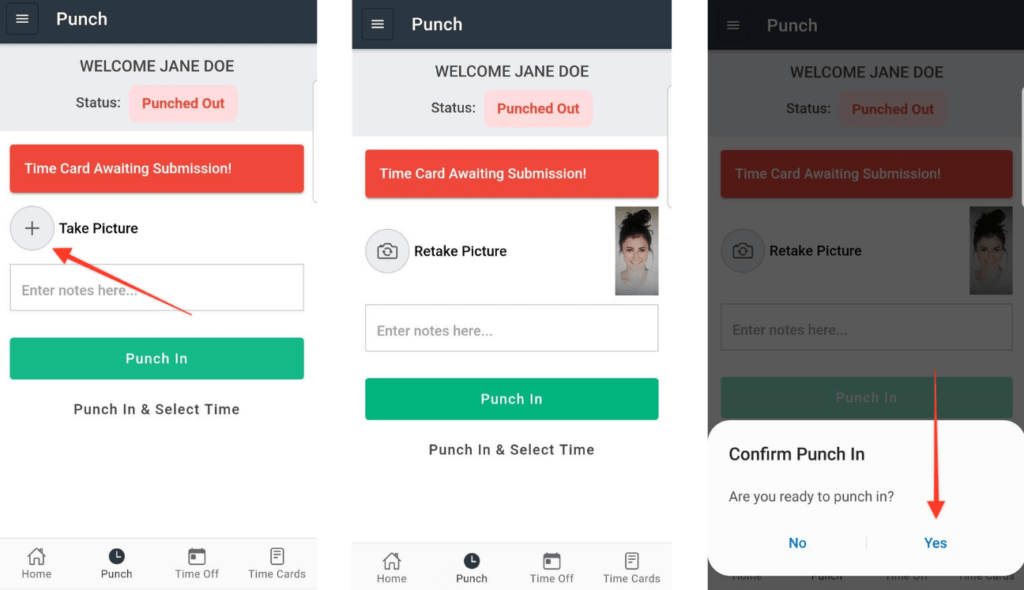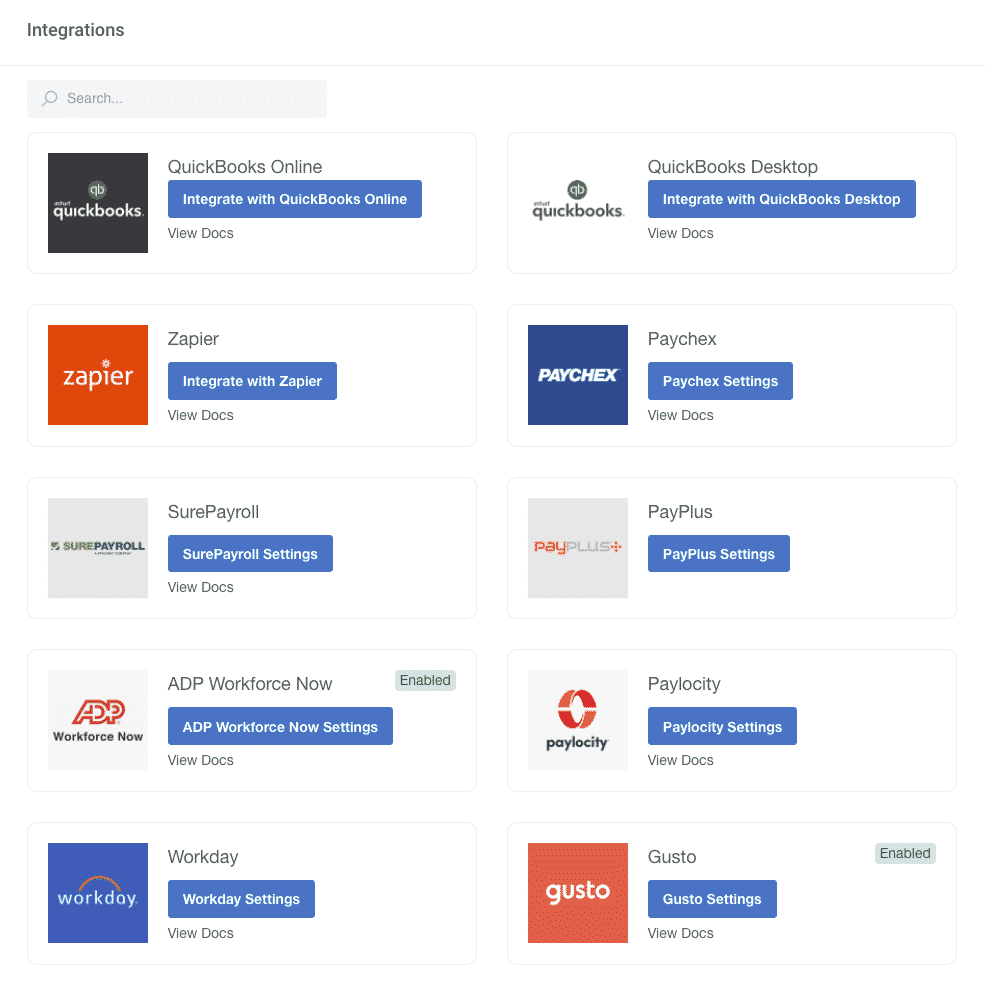4 Best Ways to Track Employee Hours (In-Depth Look)

There are multiple methods to track your employees’ hours. You can, for example, buy a physical electronic punch clock and have your employees clock in and out of work that way. A second option is to use a sheet of paper where your staff writes their name and time of punch down, and yet another alternative is to use an Excel spreadsheets or Google Sheets template.
Those three examples are “traditional” employee tracking systems. They are simple and require almost no technical knowledge — but they come with several downsides:
- Lack of Accountability: Traditional employee time tracking methods don’t help you keep your employees accountable. Inaccurate time cards and paper timesheets due to buddy punching, or other forms of lack of accountability, invariably result in high labor costs and low employee productivity. You’re either paying someone for the wrong billable hours or spending a lot of your time correcting time tracking mistakes.
- Time-Consuming and Prone to Human Error: Though recording punches using these methods is easy, the process of collecting that data manually, calculating total hours worked for each team member is an employee scheduling nightmare. You’ll spend hours analyzing your employees’ time cards and timesheets, double and triple-checking to make sure there aren’t any inaccuracies or errors in time entries — but even then you may end up with inaccurate data.
Due to the manual nature of these time management methods, you’re always at risk of (1) your employees making mistakes when inputting their time; and (2) the administrator/employer making mistakes when calculating total hours worked.
These errors and inaccuracies carry on to the payroll process and result in you either overpaying your staff, which translates to wasted time and money, or underpaying your staff, which translates to frustrated employees who feel they’ve been cheated.
This is why we argue that you should ditch traditional methods, and instead use a desktop app, such as Buddy Punch, to track your employees’ hours.
In this post, we’ll describe how Buddy Punch works, and why it’s the best way to tackle employee monitoring. We’ll also touch on how Buddy Punch can help you keep your employees accountable and streamline your payroll process.
And, since we know Buddy Punch might not fit your specific business needs, we’ll also explain how and when to use the traditional methods mentioned above, and further explore their upsides and downsides.
Table of Contents
- Why Buddy Punch Is the Best Way to Track Employee Hours
- How to Track Employee Hours with a Mechanical Punch Clock
- How to Track Time and Calculate Total Hours Using Pen and Paper
- How to Use Excel or Google Sheets to Track Employee Hours
Note: We set up to build Buddy Punch specifically because traditional employee time tracking methods were falling short of our business needs. We’re proud to say that, since our launch, we’ve helped over 10,000 businesses track time for their employees in a simple, intuitive and efficient manner. Click here to learn how Buddy Punch works, and sign up for a free trial.
Why Buddy Punch’s Time Card App Is the Best Way to Track Employee Hours

In our previous business endeavor, we learned the downsides of traditional employee time tracking methods firsthand.
During that time, we struggled tracking hours for over 20 employees across three different locations using paper punch clocks and timesheets.
This invariably led to wasted time and money due to both the inaccuracies in employee timesheets, and the many mistakes we made and had to fix each time we calculated total hours worked or ran payroll.
But we realized there had to be a better way, and we set out to build Buddy Punch.
With Buddy Punch’s clock in and clock out app, employees can punch in and out of work on their preferred device (tablet and mobile app or desktop app). This easy-to-download and use app makes Buddy Punch great for all types of teams, whether you have in-house full time employees or are working with contractors/freelancers.
That information is then collected in our platform, where everything you need to run payroll is automatically calculated. Then, you can simply export that data and hand it to your accountant or preferred payroll processing system.
If you’d rather run payroll yourself, you can simply export a payroll report, where you’ll find all your employees’ time tracking data. No need to waste time adding and subtracting hours worked manually or trying to fix errors and inaccuracies in your employees’ time cards and timesheets.
Next up, we’ll detail each of our time clock app’s key features. Feel free to either read about them one by one, or navigate to each specific feature using the list below:
Increase Accountability for Your Team with:
Streamline Payroll with:
- Buddy Punch Payroll
- Integrations
- Payroll Reports on Demand
- Time Off Tracking
- Project Tracking
- Accruals
How Buddy Punch Helps Keep Your Staff Accountable
One challenge small businesses face when tracking time for their team is that their employees are not always being honest or transparent when clocking in and out of work.
We experienced this frustration ourselves when tracking hours for over 20 employees across three business locations. To prevent the wasted time and money inherent to this lack of accountability on the part of your team, we built the following features:
Geofencing

It’s hard to keep track of employees at remote sites. Or at least it used to be – before Buddy Punch. Our Geofencing feature allows you to leverage your staff’s mobile devices to keep them accountable by creating radii inside which they can punch in and out of work.
To activate this feature, simply enter the Buddy Punch administrator dashboard and select the specific radius on the map (pictured above).
If one of your employees attempts to punch outside of the predetermined radius, they will receive an error notification on the Buddy Punch app.
One thing to note is that Geofences are not limited to just one per business or team. You can create as many geofences as you’d like, and have them work simultaneously (for multiple job sites, for example). To differentiate them, simply assign a unique job code to each.
GPS Tracking

Another feature that leverages your employees’ mobile devices’ GPS technology is GPS Tracking.
When this location tracking functionality is active, Buddy Punch will track your employees’ GPS location whenever they punch in or out of work. That data is then recorded in their timecard, and centralized in the administrator dashboard for you to review.
IP Address Locking
IP Address Locking is our third functionality with which you can limit where your employees are able to punch in or out of work. To activate this feature, access the Buddy Punch platform and designate a specific IP Address, as pictured above.
Now, if any of your employees try to punch when they aren’t connected to that network, Buddy Punch will show them an error message.
Photos on Punch

To verify whether your employees are punching in and out of work themselves, or having someone else do it in their stead, use our Photos on Punch feature.
When this feature is active, Buddy Punch will prompt your team members to take a photo of themselves before they can submit their punches.
These screenshots are then recorded in their timecards and sent automatically to the administrator dashboard, where you can review them all together, or on a per-employee basis.
Facial Recognition

To add another layer of security and accountability to all your employees’ punches, activate Buddy Punch’s Facial Recognition feature.
When you enable this feature, our app will do a biometric scan of your employees’ faces and verify it’s actually them before they can punch in or out of work (and show them an error message if not).

This feature is particularly helpful if you suspect people from your team are having coworkers punch in or out in their stead (i. e. Buddy Punching).
How Buddy Punch Streamlines Your Payroll Process
Per the below, we made it our goal to create an attendance software that lets you avoid wasting hours and dollars when running payroll manually.
Buddy Punch Payroll

You can use Buddy Punch to run payroll and pay your team. This cuts down on how many tools you need to have (you no longer need multiple tools to write schedules, track time worked, and issue payroll).
With Buddy Punch, you can choose 2-day or 4-day processing and pay your team either via direct deposit or by check.
Your employees log into a self-service portal, where they can set up their bank account info and view their paystubs.
You can also set up auto-payroll, so you’ll never miss a deadline and delay payments to your team.
But if you’re not looking to switch over your payroll process just yet, keep reading to learn how you can integrate Buddy Punch’s time tracking features with your current payroll software.
Integrations with Payroll Providers

With our Payroll Integrations, payroll processing becomes a matter of just a few clicks.
Buddy Punch integrates with most popular payroll providers (pictured above) such as QuickBooks, which means you can automate almost all, if not the entire payroll workflow.
To learn more about Buddy Punch’s payroll integrations, click here.
Payroll Reports on Demand

Another feature that helps streamline the payroll process is Payroll Reports on Demand.
This functionality allows you to automatically calculate all data needed to run payroll without leaving our platform, and then export it all in the form of an Excel or CSV payroll report (pictured above).
Data includes everything from the number of hours & minutes worked on a per-employee basis, to how much of that time was ‘overtime’, and so on.
Time Off Tracking

Thanks to our Time Off Tracking feature, both employers and employees can manage their Time Off needs without ever leaving the Buddy Punch platform.
Employees, for example, can use the Buddy Punch mobile time tracking app (iOS and Android) to request paid time off (PTO) or unpaid time off, as pictured above.
Employers (or administrators), on the other hand, receive these time off request immediately, and can use the Buddy Punch administrator dashboard to either approve or reject them:

You can also set up automated time off approval – where if your staffing requirements are met, and your employee has the available time off to take, their request is automatically approved.
To provide you with even more information related to time off, we also offer in-app time off summary:

Track Hours by Jobs, Projects, or Locations

With Buddy Punch, you can choose to view and analyze your employees’ hours segmented by “Location”, “Department” or “Position”.
To learn more about this, see this 3-minute video.
Accruals

To manage all your time off accrual needs with just a few clicks, log in to the Buddy Punch administrator dashboard and create accrual rules.
These rules can be based on the number of hours worked, a specified pay period, or an annual accrual.
Additional Features
So far, we’ve covered Buddy Punch’s essential features — those that help with time tracking, accountability, and payroll processing. But that is just the tip of the iceberg. Buddy Punch comes with many other features, including but not limited to:
- Employee Scheduling
- Overtime Calculations
- PTO Tracking
- PTO Accrual
- Adding, Editing, or Deleting Punches
- Time Card Approvals
- Job Codes / Project Tracking
- Multiple Punch and Login Options
- Alerts & Notifications
Click here to explore the full list of Buddy Punch’s features.
Other Methods to Track Employee Hours
Since we know Buddy Punch might not fit everyone’s specific business needs, below we’ll list traditional time tracking methods, and explore their upsides and downsides.
How to Track Employee Time with a Mechanical Punch Clock

Mechanical punch clocks are traditionally how most businesses have tracked their employee hours.
These clocks function very simply: The employee inserts a paper time card into the clock when they punch in or out, and the clock automatically registers the time and date of punch on the card using printer ink.
We used this method ourselves when tracking time for over 20 employees across three locations in our previous business. And at first, we were happy with its results.
We would have our employees punch using a mechanical clock, and then before each pay period, we would sit down and review all time cards, one by one, and compute all time worked on an excel sheet using a free online calculator, which we found was much easier than doing the math manually.
After we’d completed this process, we would take that information and use it to run payroll for all our employees.
But we quickly started running into problems and inaccuracies. First, a mechanical punch clock afforded us no way to keep our employees accountable. We simply had to trust that they didn’t punch out before their shift ended.
And there were other problems, including…
A Mechanical Clock Is Error-Prone and Leads to Wasted Time and Money
Calculating work hours when tracking time with a mechanical punch clock, whether you use an Excel or Google Sheets template, or pen and paper, is both time-consuming and prone to error.
This is because, in most cases, the numbers you’re dealing with aren’t rounded. Most people don’t arrive at or leave work perfectly on time. Instead, say, if their shift-start time is 8:00, they’re most likely punching in at 8:03, or 7:57.
Adding and subtracting those minutes for each of your employees can quickly get out of hand, and more likely than not, you’ll end up making many mistakes in the process, and having to check your math multiple times.
These mistakes result in one of two scenarios: You’re either overpaying or underpaying your employees. Whichever scenario you land on, you’ll need to talk to your employee to correct this mistake. If you’re overpaying them, telling them you need to subtract money from their next pay-check can be a tough conversation to have. If you’re underpaying, they’ll likely feel cheated.
Then there’s the fact that employees sometimes forget to punch, which means they either need to catch that mistake and correct it manually on their time-card, or you have to spend time tracking them down and asking if they remember when they punched on that particular day. This can happen both at the start and end of each work day or, most commonly, whenever an employee goes out to lunch or on break.
Overtime Rules & Paid Time Off
Another issue with mechanical clocks is that you have to calculate overtime and paid time off manually. When it comes to overtime, even though that information will have been registered by the punch clock on your employees’ time card, you still need to keep in mind that overtime rules can be very complicated.
In the U.S., these rules vary on a state-by-state basis and depend on the type of shift (day or night). The most common overtime rule is that if your employees work 40 hours a week, any time exceeding that is considered overtime. But this isn’t always the case.
In California, for example, overtime is calculated on a day-by-day instead of a week-by-week basis. This means that if your employees work 10 hours on any given day, those extra 2 hours are considered overtime, even if the weekly total amounts to less than 40 hours.
When it comes to paid time off, you’re off on your own. Mechanical punch clocks offer no aid in this domain, meaning you are left calculating PTO manually and separately during each pay period or at the end of any given week or month.
Physical Time Cards Are Easily Damaged and/or Lost
The last problem inherent to mechanical time clocks is that they come with physical limitations. Employees have only one time card at any given time, which can be easily lost or damaged.
In that case, you’ll have to replace that paper time card, risk losing all information already recorded in the original, and have to recreate it from memory.
Another example of a physical limitation inherent to mechanical clocks is that, because of the printer-like method in which these devices record punches, sometimes two punches are recorded on the same spot of the card.
In cases like these, more often than not, you’ll end up with a completely illegible punch, or one in which the date has been recorded but the exact time is illegible, or vice versa.
How to Track Time and Calculate Total Hours Using Pen and Paper

A good alternative to using a mechanical punch clock to track time is to have your employees write down the time of punch (in and out) on a sheet of paper, ideally a calendar.
For example, if one of your employees entered work at nine and left at five, then he or she would write down exactly that on a particular day in the calendar. Then, before each pay period, you can simply look at the calendar and calculate total work time per employee.
This method of time tracking comes with one major upside: it is simple and intuitive.
On the employer side, they don’t have to worry about losing their time-card, for example. On the employee side, the numbers are rounded — no one is going to write down “I arrived at 7:59” when their shift starts at 8. They will simply write 8:00, and be done with it. This means you don’t have to do complex calculations at the end of each week or before each pay period. And the easier the calculations, the fewer mistakes you’re prone to make.
But, despite its simplicity, this method comes with many of the same problems as tracking time with a mechanical clock does.
Calculating work hours, for example, is still a time-consuming process that requires extreme attention, and is liable to errors. And if you do end up making errors, the consequences are the same: you either overpay or underpay your employees, which, as mentioned above, is not a scenario you want to find yourself in.
Similarly, a paper calendar or sheet offers you no help when trying to calculate PTO or overtime, meaning here too, you’re left to do it manually, with all the risks and complications that entails.
How to Use Excel or Google Sheets to Track Employee Hours

Another way to track employee hours is via Excel or Google Sheets.
This method works similarly to the two mentioned above — the only difference is that, instead of having your employees punch in using a mechanical time clock or writing on a sheet of paper, you have them register their punches on a digital file.
The obvious upside to this method is that you don’t risk losing or damaging a piece of paper, and instead you can set things up so, even if your computer or tablet breaks, you’ll have backups of your Excel or Google Sheets file elsewhere.
Another upside is that you skip one step of the payroll process: instead of having to manually transfer all data from paper to your computer, you can simply email the Excel file to your payroll provider.
When using an Excel or Google Sheets file, the process of calculating total billable hours does get a little bit easier, since you can set up things so it does all that math automatically. That said, the process is still somewhat manual, with all the risks that entails.
Your employees still need to sit down and write down the time and date of their punches, meaning they can easily forget to punch, or make a mistake when recording (writing 8:15 when they punched in at 8:05, for example).
Also, using Excel or Google Sheets to track employee hours does not take into account overtime and paid time off, at least not by default. You could theoretically set things up so the digital file calculates them in real-time, but that process in itself requires technical knowledge (i.e. Excel macros) and can be extremely time-consuming.
More often than not, business owners that use this method as their time tracker end up inputting overtime and PTO data separately.
Note: We set up to build Buddy Punch specifically because traditional time tracking tools were falling short of our business needs. We’re proud to say that, since our launch, we’ve helped over 10,000 businesses track time for their employees in a simple, intuitive and efficient manner. Click here to learn how Buddy Punch works, and sign up for a free trial. Pricing is flexible depending on your workforce size and desired functionalities.
For more information on time tracking and employee time management, check out our posts on:
